

TeachingEnglish Jukebox. Beyond Gap Fills. Using songs to learn a language. Why, how and which? At the beginning of this year, I was surprised to find out that many of my students, especially adults, stated in the Needs Analysis that they wanted to use songs.
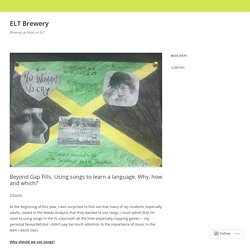
I must admit that I’m used to using songs in the YL classroom all the time (especially clapping games – my personal favourite!) But I didn’t pay too much attention to the importance of music in the teen / adult class. Why should we use songs? I think we all know why, but here’s a couple of reasons I’ve come up with. They can be fun.They generate interest in the target language culture.Some are catchy and students keep singing them at home.Students can feel motivated to learn on their own by googling more songs by the same artist / similar genre.Some songs can be used to teach language points.Karaoke is fun and useful to acquire pronunciation features.You can deal with the physical aspect of pronunciation; singers tend to move their mouths a lot. How? Fist thing that comes to our heads? Wish you were here – Pink Floyd (wishes)
Online Reading Activities. Search- Level, Theme, Task, Artist. Sound Factory. The Best — And Easiest — Ways To Use YouTube If, Like Us, Only Teachers Have Access To It. I’ve previously mentioned that our district recently loosened up its content filter to allow teachers to access many previously-blocked sites, like YouTube, Twitter, Facebook, etc.

This has created some great learning opportunities for our students, and I thought I’d bring together the ways I’ve begun using this access through a classroom projector. You might also be interested in The Best YouTube Channels For Learning English. I’m definitely eager to hear other ideas from readers, too. Here are my choices for The Best — And Easiest — Ways To Use YouTube If, Like Us, Only Teachers Have Access To It: ESL Video has been on previous “The Best…” lists. Lyrics Training shows YouTube videos of the latest popular songs, and provides subtitled “clozes.”
Batlyrics has been on The Best Places To Find Lyrics On The Web list for awhile. Instalyrics is a new site that shows you the lyrics to any song very, very quickly, along with a music video that goes along with it. Related June 21, 2011. The Best Music Websites For Learning English. Check out my New York Times post for English Language Learners focuses on using music for language development and includes a student interactive, video, and teaching ideas.
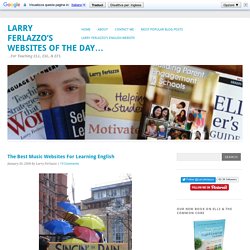
I use music a lot in my teaching of English Language Learners. I thought people might find it helpful to see which sites I believe to be the best out there to help teach English — Beginning, Intermediate, and Advanced — through music. My students have certainly found them helpful. Music is a familiar, fun, and engaging tool to use in learning a second language. Learn Languages with Music Videos, Lyrics and Karaoke! Mondos: Song Lessons. Wonderful World. MAIN ACTIVITIES Listening, discussion, vocabulary of animals and geographical features.
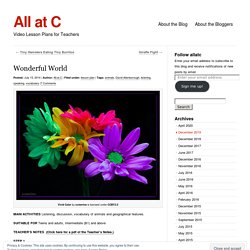
SUITABLE FOR Teens and adults, Intermediate (B1) and above TEACHER’S NOTES (Click here for a pdf of the Teacher’s Notes.) Display this word cloud or make your own at Tell students that it contains the lyrics of a well-known song. Give them a minute to try and identify the song. Display the second word cloud, which contains the song title. Tell them to draw a grid four squares by four squares. Play the video – sound only, with the screen blank. Display or hand out a copy of the lyrics so that students can see where their words appear in the song and check new vocabulary if necessary.
Put students in pairs and assign each pair two lines of the song. Wonderful World. How to use songs in the English language classroom. What makes for a successful song-based lesson?
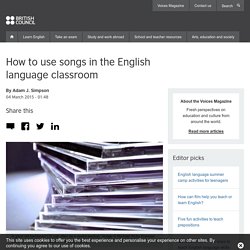
Adam Simpson, second-time winner of the British Council’s Teaching English blog award for his post on conditionals (written with Paul Mains), explains. One of the big problems we all face, whether teaching English to children or adults, is maintaining learners’ interest throughout our lessons. Consequently, we often have to be very creative in the techniques we use. What makes music such a great teaching tool is its universal appeal, connecting all cultures and languages. This makes it one of the best and most motivating resources in the classroom, regardless of the age or background of the learner. Planning for the use of songs in class The process of selecting a song is one of the most difficult aspects of using music in a lesson. Carefully examine what it is you want your class to learn in the lesson Is this going to be a lesson focusing on vocabulary, grammar, pronunciation, or a particular topic?
How old are your learners? 1. 2. 3. 4. How to use songs in the English language classroom. Wow!
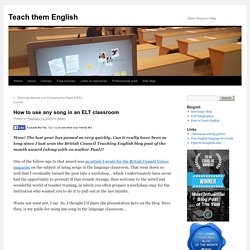
The last year has passed so very quickly. Can it really have been so long since I last won the British Council Teaching English blog post of the month award (along with co-author Paul)? How to use songs in the English language classroom. 6 Activities you can do online with songs and music.